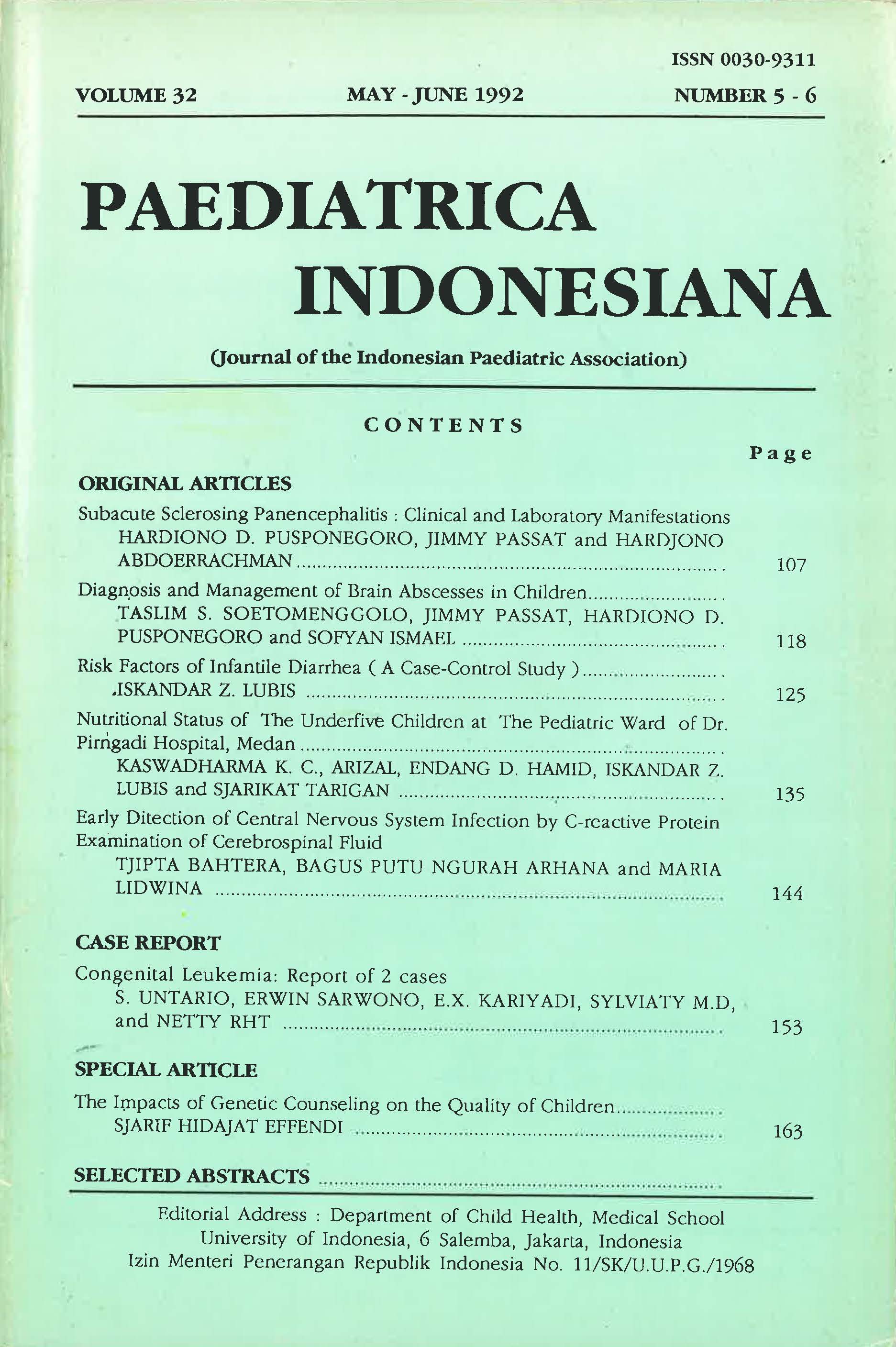Diagnosis and Management of Brain Abscesses in Children
DOI:
https://doi.org/10.14238/pi32.5-6.1992.118-24Keywords:
brain abscess; increased intracranial pressure; focal neurological disordersAbstract
During 4 years, 20 patients with brain abscesses were hospitalized in the Departement of Child Health, Dr. Cipto Mangunkusumo General Hospital, jakarta. Of those 20 patients 11 were males and 9 were females. The youngest patient was 2 months old and the oldest was 12 years old. The important signs and symptoms in making diagnosis were the sign of injection, increased intracranial pressure, and focal neurological disorders. Laboratory examinations were of little value in establishing the diagnosls of brain abscess. By performing head CT Scan the diagnosis of brain abscess will be confirmed accurately. Of the 20 patients, 15 (75 %) suffered from single abscess and 5 (25 %) suffered from multiple abscesses. The results of treatment by surgical intervention were better than nonsurgical treatment. The high mortallty of the nonsurgical patients was caused by the severity of the disease due to the ignorancy of their parent.
References
2. Joubert MJ, Stephanov S. Computerized tomography and surgical treatment intracranial suppuration : Report of 30 consecutive unselectyed cases of brain abscess and subdural empyema.] Neurosurg 1977; 47: 73-8.
3. Liston TE, Tomasovic JJ, Stevens EA. Early diagnosis and management of cerebritis in a child. J Pediat 1979; 65 : 484-6.
4. Choudhury AR, Taylor JC, Whitaker R. Primary excision of brain abscesses. Br Med J 1977; 2 : 1119-21.
5. Jahn AJ, Snell GED. Otogenic intracranial complications. J Otolaringol 1980; 9 : 184- 93 (Cited by Britt, 1985).
6. Carey ME, Chou SN, French LA. Experience with brain abscesses. J Neurosurg 1972; 36 : 1-9.
7. Hagan RA. Early complication following penetrating wounds of the brain. J Neurosurg 1971; 34 : 132 - 41.
8. Beller A], Sahar A, Praiss I. Brain abscess : review of 89 cases over a period of 30 years. J Neural Neurosurg Psychiatry 1973; 36: 757-68.
9. Britt RH, Enzmann DR. Clinical stages of human brain abscess on serial CT scan after contrast infusion. Computerized tomographic; neuropathological, and clinical correlations. J Neurosurg 1983; 59 : 972-89.
10.Snyder RD. Brain abscess. In : Swaiman, ed. Pediatric neurology, principles and practice. Toronto: Mosby, 1989: 463-4.
11.Weil ML. Brain abscesses. In : Menkes ed. Texbook of child neurology, 4th. ed. London: Lea & Febiger, 1990: 349 - 53.
12.Rosenblum ML, Hoff JT, Norma D, Edwards MS. Berg BO. Nonoperative treatment of brain abscesses in selected highrisk patients.] Neurosurg 1980; 52 : 217-25.
Downloads
Published
How to Cite
Issue
Section
License
Authors who publish with this journal agree to the following terms:
Authors retain copyright and grant the journal right of first publication with the work simultaneously licensed under a Creative Commons Attribution License that allows others to share the work with an acknowledgement of the work's authorship and initial publication in this journal.
Authors are able to enter into separate, additional contractual arrangements for the non-exclusive distribution of the journal's published version of the work (e.g., post it to an institutional repository or publish it in a book), with an acknowledgement of its initial publication in this journal.


















